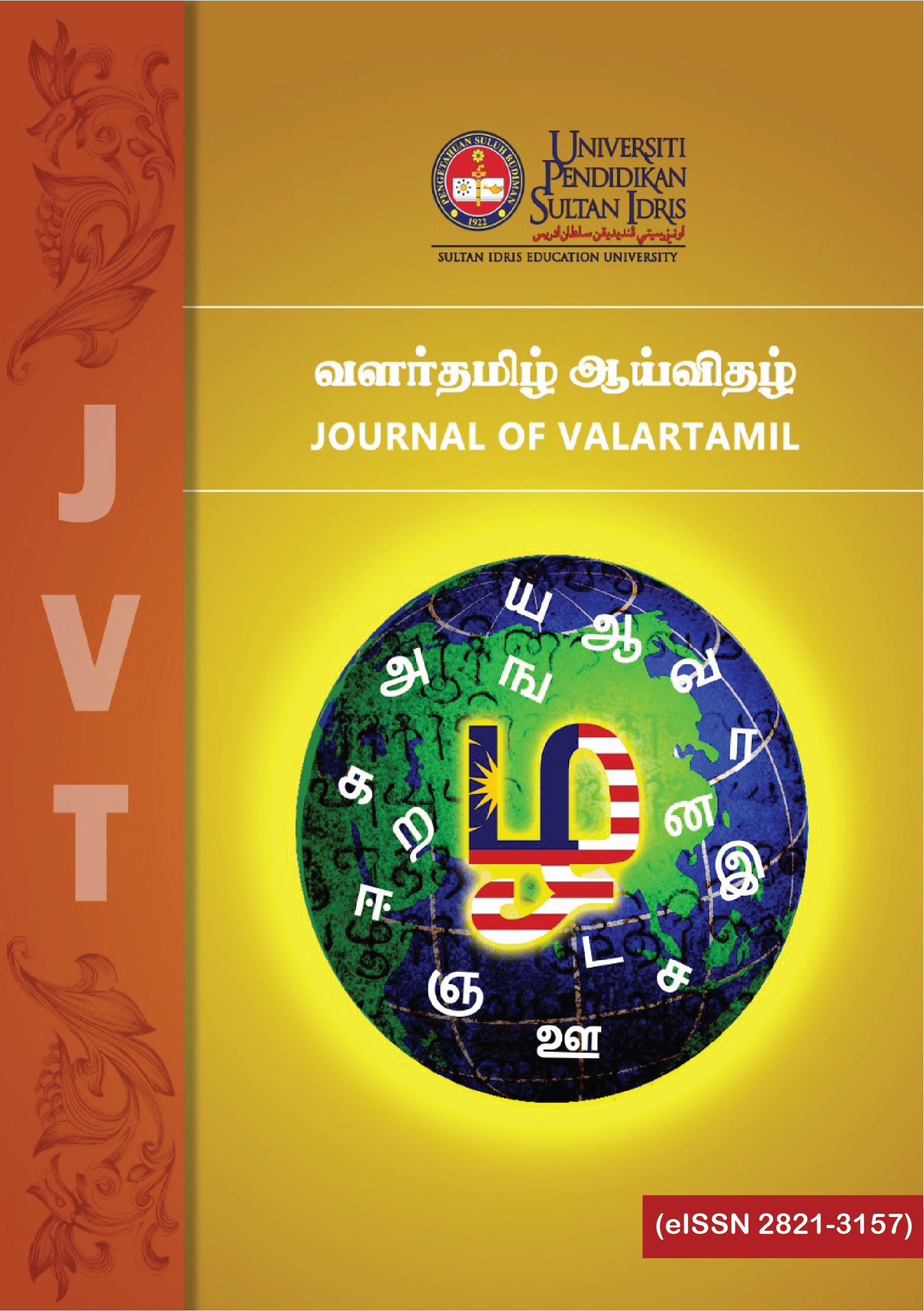குறள் வாசிப்பு வழி சிந்தனைத் திறன் மேம்பாடு
Improving Thinking Skills Through Kural Reading
DOI:
https://doi.org/10.37134/jvt.vol2.1.9.2021Keywords:
ஆய்வுச்சிந்தனை, குறள் வாசிப்பு, சிந்தனைத் திறன், மொழிAbstract
கல்வியின் முக்கிய நோக்கம் மாந்தனின் சிந்தனை ஆற்றலை வளப்படுத்துவதாகும். மாந்தனின் சிந்தனையை வளப்படுத்துவதில் மொழி முக்கியப் பங்காற்றுகிறது. மொழி மாந்தனின் தொடர்பு ஊடகமாக விளங்கி அவனுடைய எண்ணங்களையும் சிந்தனைகளையும் வெளியிடுவதற்கு உதவுகிறது. சிந்தனை என்பது மூளை செயற்பாங்கின் விளைவாகும். “சிந்தனைக்கு முக்கியக் கருவியாக விளங்குவது மொழி” என்ற கருத்தைப் பியாஜே, புரூனர், வைகாட்ஸ்கி முதலிய உளவியலாளர்களும் அறிவுறுத்தியுள்ளனர். எனவே, சிந்தனையிலிருந்து மொழியைப் பிரித்தறிய முடியாது. அவ்வடிப்படையில் தம் சிந்தனையின் வெளிப்பாட்டினைக் குறள் வெண்பா வடிவில் திருக்குறளை அமைத்தவர் வள்ளுவர். வள்ளுவர் 1330 குறள்களை 133 அதிகாரங்களின் கீழ் தொகுத்து, அறம், பொருள், இன்பம் ஆகிய மூன்று பால்களின் அடிப்படையில் படைத்துள்ளார். வள்ளுவரின் குறள்களை அதிகார அடிப்படையில் ஆய்வுச் சிந்தனையோடு வாசித்துச் சிந்தனைத் திறனை எவ்வாறு வளர்க்கலாம் என்று எடுத்துரைப்பதே இவ்வாய்வின் நோக்கமாகும்.The main purpose of education is to enrich the thinking power of human. Language plays an important role in enriching one's thinking. Language serves as a medium of human communication and helps to express his thoughts and ideas. Thought is the result of brain activity. Psychologists such as Piaget, Bruner, and Vygotsky have stated that 'language serves as an important tool for thinking.' Therefore, language cannot be distinguished from thought. So thus, Valluvar has formed the Kural Venpa that nurtures the expression of his thought. Valluvar has compiled 1330 kural under 133 chapters and created them on the basis of three components namely aram, porul and inbam. Purpose of the this study is to explore the kural produced by Valluvar in terms of chapters and read it with critical thinking on how to develop thinking skill.
Keywords: Critical thinking, Kural reading, Language, Thinking skill
Downloads
References
Azizi, S. (2021). Sikap dan Kesediaan Pelajar Tingkatan Empat Terhadap Perlaksanaan Kemahiran Berfikir Aras Tinggi dalam Pembelajaran Matematik. Malaysian Journal of Social Sciences and Humanities (MJSSH) Volume 6, Issue 3. Universiti Kebangsaan Malaysia, Bangi.
Annathurai, K. (2016). Tirukkural Dalam Kurikulum Bahasa Tamil Sekolah Rendah Dan Menengah: Satu Kajian Persepsi Dan Amalan Ke Arah Pembentukan Insan Holistik.Tesis PhD Fakulti Sastera Dan sain Sosial, Universiti Malaya.
Bloom, B.S. (ed) (1983). Taxonomy of Educational Objectives Cognitive Domain New York David MC Key Co.
Brandt, L., & Brandt, P. A., (2005). Making sense of a blend: A cognitive-semiotic approach to metaphor. Annual Review of Cognitive Linguistics, 3(1), 216-249.
Che Zanariah, H.& Fadzilah, R. (2011) Pelaksanaan Pengajaran Dan Pembelajaran Kemahiran Menulis Di Sekolah Rendah Jurnal Pendidikan Bahasa Melayu Vol. 1, Universiti Kebangsaan Malaysia, Bangi.
Chomsky, N. (1972) Language and Mind New York. Haccourt Bracc.
Curriculum Development Division. (2003). KBSM Tamil language Syllabus (Sukatan Pelajaran Bahasa Tamil Kurikulum Bersepadu Sekolah Menengah). Ministry of Education Malaysia. Putrajaya.
Hadi, D. R. (2012). KBKK dan Aplikasi dalam P&P. Retrieved from Persatuan Pengamal Pendidikan Malaysia.
Ministry of Education Malaysia. (2014). Higher order thinking skills application in school (Kemahiran berfikir aras tinggi aplikasi di sekolah). Curriculum Development Division, Putrajaya.
Montag-Smit, T., & Maertz Jr, C. P., (2017). Searching outside the box in creative problem solving: The role of creative thinking skills and domain knowledge. Journal of Business Research, 81, 1-10.
Narayanasamy, K. (2012). Sinthikka Karpittalum Sinthanaiyai Karpittalum: Kuala Lumpur Raden Creative.
Rajendran, N. (2008). Asiriyam Malaysiyavil Tamil Kalviyum Karral Karpittalum. Kuala Lumpur Uma Publicaton:
Selvajothi, R. (2009). Penggunaan Bahasa Kiasan dalam Karya Thirukkural: Satu Analisis. (Disertasi Sarjana Bahasa Moden) Fakulti Bahasa dan Linguistik: Universiti Malaya.
Supramani, S. (1994). Sintanai Thiranai Valarppathil Vinaakkalin Payanpaadu. 2nd International Tamil teachers Conference. Kuala Lumpur.
Upiq Asmar Zainal Abidin dan Ragu Ramasamy. (2015). Persepsi Guru Terhadap Kemahiran Berfikir Aras Tinggi Dalam Pengajaran Dan 145 Pembelajaran Di Sebuah Sekolah.
International ASEAN Comparative Education Research Network Conference. Kajang. Malaysia.
Zoya, G. Khanova. (2021). Distance learning of psychology students in the context of a pandemic: an analysis of the experience gained. SHS Web of Conferences 103, International Scientific and Practical Conference.





